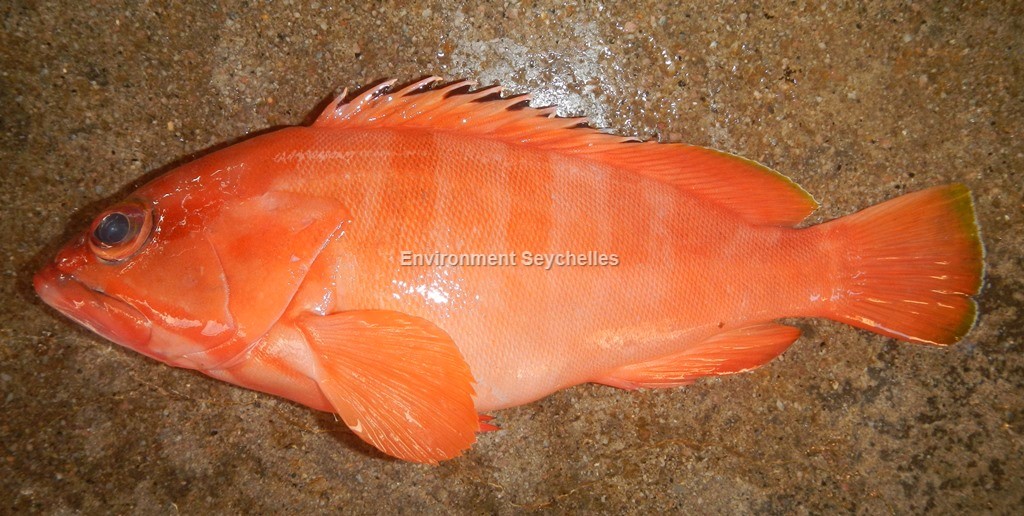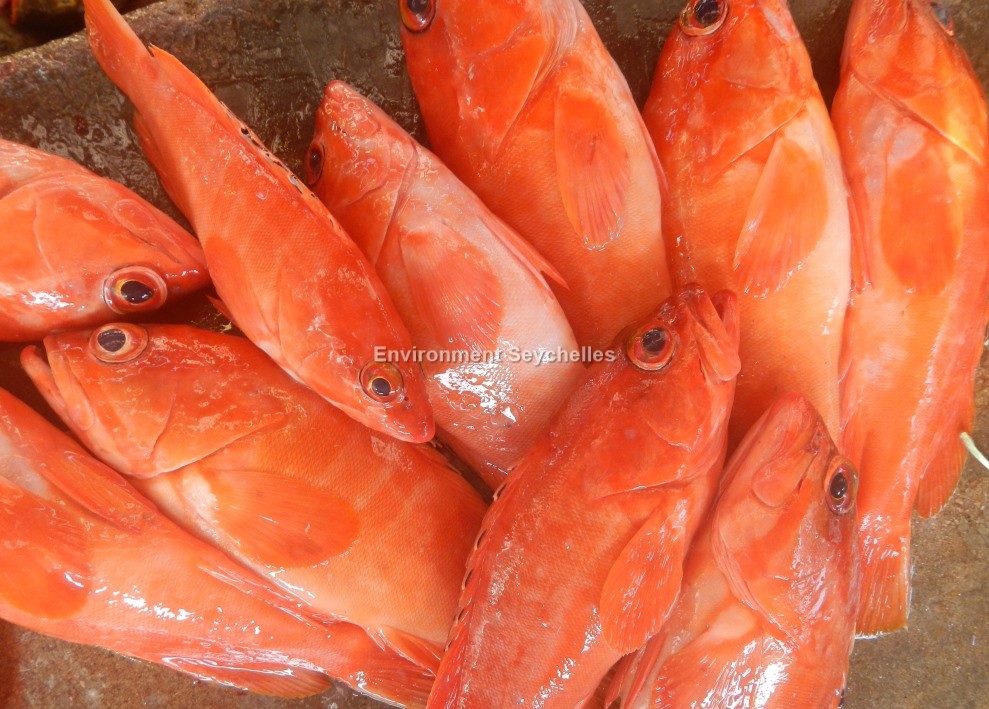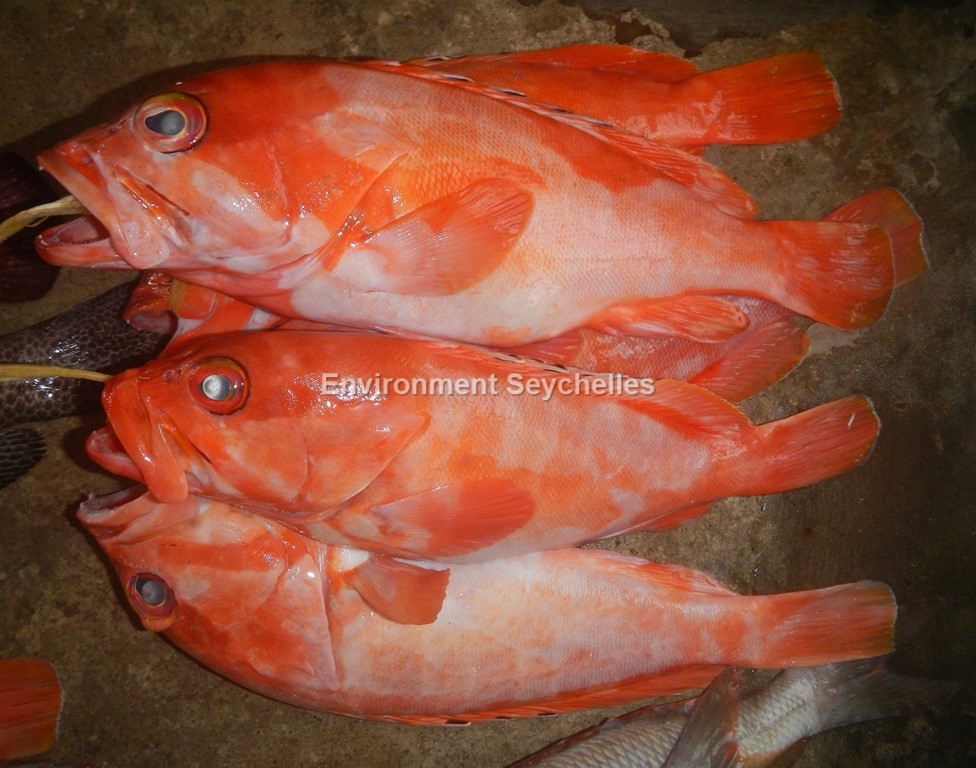Description:
Dorsal spines: 11; Dorsal rays: 15-17; Anal spines: 3; Anal rays: 8.
Small to medium-sized, moderately full-bodied grouper. Flate interorbital area. Dorsal head profile convex. Subequal posterior and anterior nostrils. Maxilla reaches to
below rear third of eye or a little past eye. 2-4 rows of teeth on midlateral part of lower jaw. Rounded preopercle, finely serrate rear edge, with lower most serrae slightly
enlarged. Upper edge of operculum straight. Ctenoid scales on body except cycloid anterodorsally above lateral line and on thorax and ventrally on abdomen. Rounded caudal fin.
Colour. Pale orange red to bright red fish with contrasting dark and light red bars on the back and flanks (5 to 6 dark bars the last on the peduncle). Distinctive black membrane
between dorsal spines. Dorsal part of the head and nape including the upper jaw, dark red or reddish brown. Rim of the orbit black. Fins reddish orange.
Size:
Maturity: Lm unknown. Range 16-? cm. Max Length: 40 cm.
Habitat and Ecology:
Reef associated, common on outer reef slopes (depth range 4-160 m, but usually 20-45 m). Also occurs in protected bays. In Seychelles, it is commonly seen resting in open
rocky areas more than in dense coral areas (Howlett et al. 2016). Feeds on fish, shrimp, crabs and octopus. Recorded to form spawning aggregations. Exhibits a combination of
simultaneous and sequential hermaphroditism. Smaller individuals within a social group are simultaneous hermaphrodites, while the largest often lose female function and
reproduce exclusively as a male.
Fishery Status:
This species is not protected or subject to fishery regulations. It is caught in the hand line and trap fisheries. It is a frequent though not particularly abundant component
of the catch.
Notes:
References:
Craig, M.T. et al. (2011). Groupers of the World - a field and market guide. NISC (Pty) Ltd, South Africa. ISBN: 978-1-920033-11-8
Froese, R. & D. Pauly. (Eds.) (2019). FishBase. https://www.fishbase.de/summary/Epinephelus-fasciatus.html (06/01/19).
Heemstra, P.C. & Randall, J.E. (1993). Groupers of the World. Vol. 16 FAO Species Catalogue. FAO Fisheries Synopsis No. 125, Volume 16. FIR/S125 Vol. 16
Howlett, S.J. et al. (2016). Linking Protection with the Distribution of Grouper and Habitat Quality in Seychelles. Journal of Marine Biology. Volume 2016, Article ID 7851425,
10 pages. http://dx.doi.org/10.1155/2016/7851425
Law, C. (2018). Epinephelus fasciatus. The IUCN Red List 2018: http://dx.doi.org/10.2305/IUCN.UK.2018-2.RLTS.T132817A100544403.en. (06/01/19)
Nevill, J. (2013). A Species Identification Guide for Commonly Caught Fish in the Seychelles Near-Shore Artisanal Fishery. GOS/UNDP/GEF.
Citation:
Nevill, J.E.G. (2019). Epinephelus fasciatus, Blacktip grouper. Seychelles Seatizens. www.seatizens.sc. https://seatizens.sc/species/epinephelus-fasciatus-forsskal-1775/ (revised 26/07/22).




This is not to be taken as joining God or a creator because the cosmic consciousness that Fenwick describes did not create the universe but is simply a property of it.ラブドール おすすめObviously,
エロ ラブドールthe gaslighter escalates the dispute by doubling and tripling down on their attacks,refuting substantive evidence with denial,
Keep your eyes peeled for when Mei finds a physician to graft 初音 ミク ラブドールa horse penis onto his individual appendage.
pin up giris: pin up 360 – pin up kazino
pin-up 141 https://azerbaijancuisine.com/# pin up yukle
pin up 360
https://northern-doctors.org/# mexico drug stores pharmacies
mexican pharmacy: northern doctors – medicine in mexico pharmacies
http://northern-doctors.org/# mexican drugstore online
medicine in mexico pharmacies Mexico pharmacy that ship to usa medication from mexico pharmacy
https://northern-doctors.org/# mexican mail order pharmacies
buying from online mexican pharmacy: Mexico pharmacy that ship to usa – mexico pharmacy
https://northern-doctors.org/# mexican mail order pharmacies
pharmacies in mexico that ship to usa northern doctors pharmacy medication from mexico pharmacy
mexico pharmacy: mexican pharmacy northern doctors – mexico pharmacies prescription drugs
http://northern-doctors.org/# mexican online pharmacies prescription drugs
mexico drug stores pharmacies: mexican pharmacy northern doctors – mexican drugstore online
https://northern-doctors.org/# mexican mail order pharmacies
mexico drug stores pharmacies: northern doctors – mexico drug stores pharmacies
http://northern-doctors.org/# medication from mexico pharmacy
buying from online mexican pharmacy: mexican pharmacy northern doctors – mexican mail order pharmacies
http://northern-doctors.org/# mexican mail order pharmacies
mexican online pharmacies prescription drugs: northern doctors – best online pharmacies in mexico
mexican border pharmacies shipping to usa: northern doctors – mexican online pharmacies prescription drugs
buying prescription drugs in mexico online: northern doctors – buying from online mexican pharmacy
mexican rx online: п»їbest mexican online pharmacies – mexican rx online
mexico drug stores pharmacies mexican pharmacy online mexican drugstore online
mexico drug stores pharmacies: mexican pharmacy northern doctors – mexico pharmacies prescription drugs
https://northern-doctors.org/# mexican drugstore online
mexico drug stores pharmacies: mexican northern doctors – п»їbest mexican online pharmacies
https://northern-doctors.org/# mexican drugstore online
buying from online mexican pharmacy mexican online pharmacies prescription drugs mexican pharmaceuticals online
mexican pharmaceuticals online: Mexico pharmacy that ship to usa – reputable mexican pharmacies online
https://northern-doctors.org/# mexico drug stores pharmacies
mexican drugstore online: mexican pharmacy online – mexican pharmaceuticals online
https://northern-doctors.org/# medication from mexico pharmacy
mexico drug stores pharmacies: Mexico pharmacy that ship to usa – mexico drug stores pharmacies
mexican pharmacy: mexican pharmacy online – medicine in mexico pharmacies
http://northern-doctors.org/# mexico drug stores pharmacies
This article is a gem! The insights provided are very valuable. For additional information, check out: DISCOVER MORE. Looking forward to the discussion!
reputable mexican pharmacies online mexican northern doctors medicine in mexico pharmacies
https://northern-doctors.org/# medicine in mexico pharmacies
ラブドール オナホ(Bailey)3.Women’s bodies are ubiquitously eroticized in popular media and therefore women may be doing the same when viewing sexual stimuli depicting women.
https://northern-doctors.org/# mexican drugstore online
mexico pharmacies prescription drugs: Mexico pharmacy that ship to usa – buying from online mexican pharmacy
mexico pharmacies prescription drugs: northern doctors – mexico drug stores pharmacies
http://northern-doctors.org/# reputable mexican pharmacies online
medicine in mexico pharmacies northern doctors pharmacy pharmacies in mexico that ship to usa
https://northern-doctors.org/# mexican online pharmacies prescription drugs
mexican pharmaceuticals online: mexican pharmacy northern doctors – reputable mexican pharmacies online
https://northern-doctors.org/# mexican rx online
http://northern-doctors.org/# mexico pharmacy
п»їbest mexican online pharmacies: Mexico pharmacy that ship to usa – purple pharmacy mexico price list
https://northern-doctors.org/# mexican pharmaceuticals online
many women have difficulty with orgasms because they don’t know that their clitoris needs to be stimulated,人形 えろand they may even feel ashamed at doing so.
mexican pharmaceuticals online cmq pharma mexican pharmacy mexican border pharmacies shipping to usa
http://cmqpharma.com/# purple pharmacy mexico price list
medicine in mexico pharmacies
ラブドール おすすめwrecks the most established of momentum,and ends up making us feel mentally down.
Also, you can get specific parts like sex doll torsos.ラブドール sex This means people can choose exactly what they want, making their experience with these dolls much more personal.
ラブドール と はMs.Nooyi presented quarterly forecasts for the main divisions of the company.
housed atop a pile that continued to grow with each passing news cycle as stories with this same script fell again and again.Once again I experienced the dull ache of hopelessness when it comes to living within a society that has no adequate solutions to deal with perpetrators of sexual violence.ダッチワイフ と は
中国 エロcom has something for everyone.The site’s extensive selection ensures that you can find a doll that meets your specific interests and needs.
northwest pharmacy canada canada online pharmacy canadian pharmacy store
reliable canadian online pharmacy: canadian pharmacy scam – canadian drugs pharmacy
Another is social influence.ドール エロWe all have biological features and tendencies,
mexican pharmaceuticals online: mexican border pharmacies shipping to usa – reputable mexican pharmacies online
indian pharmacy paypal п»їlegitimate online pharmacies india reputable indian online pharmacy
https://canadapharmast.com/# canadian pharmacy antibiotics
buy medicines online in india: buy medicines online in india – online shopping pharmacy india
best canadian online pharmacy canadian pharmacy near me canadian pharmacy
pharmacies in mexico that ship to usa mexico pharmacies prescription drugs mexican pharmacy
mexican border pharmacies shipping to usa: mexico pharmacy – buying prescription drugs in mexico
https://clomiddelivery.pro/# can i get cheap clomid online
ラブドール 中古and calm energy,” Ross launched Feel Free as a wellness beverage.
https://paxloviddelivery.pro/# paxlovid india
how to get generic clomid no prescription: generic clomid online – can i order generic clomid pills
https://amoxildelivery.pro/# amoxicillin without prescription
ciprofloxacin generic: buy cipro online – buy cipro no rx
https://ciprodelivery.pro/# buy generic ciprofloxacin
http://clomiddelivery.pro/# how can i get cheap clomid online
結論から言えば警察がアウトと判断したら捜査が行われ、セックス ロボット検察がアウトと判断したら起訴が行われ、裁判所がアウトと判断したら法で裁かれるということになります。
http://amoxildelivery.pro/# buy amoxil
amoxicillin online pharmacy: amoxicillin 500mg price canada – can you buy amoxicillin over the counter in canada
https://doxycyclinedelivery.pro/# doxycycline 30
Sex dolls are also sought for sexual fulfilment. With the irontech dolladvancements in their design, they can provide a realistic sexual experience